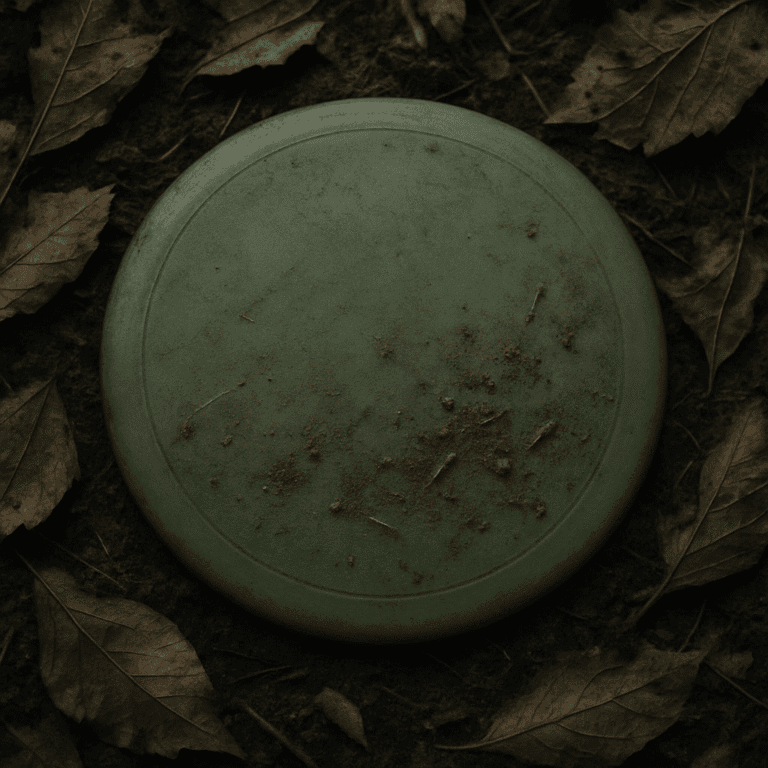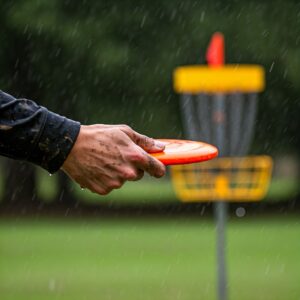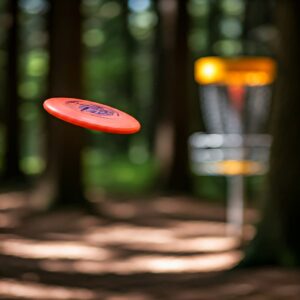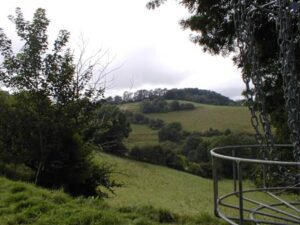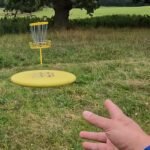Disc golf is booming — more courses, more players, more plastic. But while we obsess over overstable flight paths and perfecting our drives, we’re trampling something less discussed: the planet beneath our feet. The environmental impact of disc golf is real, measurable, and often ignored. And yet, with a few smart choices, the sport could become a model of outdoor sustainability.
Understanding the Environmental Impact of Disc Golf
Before we talk sustainability, we need to understand the real environmental impact of disc golf — how our courses, habits, and gear shape the natural areas we play in.
Imagine playing a round, weaving through trees and open fairways. Each step and throw interacts with the environment, sometimes in ways we don’t immediately notice. The adrenaline is pumping as you launch your disc towards the basket, but have you ever stopped to consider how these actions affect the environment?
1. Foot Traffic: Disc golf courses see a significant amount of foot traffic, particularly on popular courses. Over time, this can lead to soil compaction and erosion, which can impact plant life and water drainage.
2. Wildlife Disruption: Our courses are often nestled in natural surroundings, which means we share the space with local wildlife. Frequent human activity can disrupt their habitats and routines, affecting local ecosystems.
3. Litter and Pollution: While most disc golfers are responsible and clean up after themselves, stray plastic, cans, and wrappers can still find their way onto the course. This litter harms the environment and detracts from the natural beauty of the game.
Now, you might be thinking, “Okay, I get it. Disc golf can have a footprint, but what can I do about it?”
Are Disc Golf Discs Biodegradable?
Most disc golf discs are made from durable plastics like polyethylene or polypropylene — materials that can outlive your arm speed by centuries. They’re typically made from plastics like polyethylene or polypropylene, which can take hundreds of years to break down in landfills.
Now, don’t get me wrong; I’m not suggesting we give up our beloved plastic discs. They’re durable and essential for the sport. However, there are eco-friendly alternatives available. Disc manufacturers have been exploring more sustainable materials like recycled plastics or bioplastics, which break down more quickly than traditional plastics.
Disc Brands Reducing the Environmental Impact of Disc Golf Equipment
Some disc brands are tackling the environmental impact of disc golf head-on. They’re not just greening their supply chains — they’re turning recycled plastic into putters and powering factories with renewable energy. Here’s how they compare.
Table current as of June 2025.
| Company/Brand | Eco-Friendly Practices | Materials Used | Notable Initiatives | Source |
|---|---|---|---|---|
| Trash Panda | 100% recycled discs, disc recycling program, B Corp certified | Post-consumer & post-industrial recycled plastic | Disc recycling, clean-ups, collaborations | Source |
| AGL Discs | Mostly recycled plastic, tree planting, zero landfill waste | Recycled plastic, hemp bioplastic | Tree seeds, Tree-Nation partnership | Source |
| Ocean Discs | 60% ocean-sourced recycled plastic | Recycled ocean plastic (60%), new plastic (40%) | Marine waste reduction | Source |
| Latitude 64 / Trilogy | Recycled lines, factory runs on 100% renewable energy | Recycled production waste | Renewable-powered factory | Source |
| MVP Disc Sports | R2 Neutron recycled line | Recycled Neutron production waste | Distinctive recycled line | Source |
| Clash Discs | Plant-based bioplastic (Planty line) | Plant-derived oils (bio-based, not biodegradable) | Planty bioplastic line | Source |
| Eurodisc | 100% recyclable, petroleum-free, green energy production | Organic, bio-based, recyclable plastic | Green-powered, short supply chain | Source |
| Discraft | Recycled ESP plastic, waste reduction in manufacturing | Reprocessed ESP scraps | Operational efficiency | Source |
How Disc Golfers Can Reduce Their Environmental Footprint
- Pick up after yourself: Always carry out what you bring in. Leaving no trace helps maintain the natural beauty of the courses. When you finish a hole, take a moment to pick up any litter you see, even if it’s not yours. Leave the course cleaner than you found it.
- Support sustainable disc manufacturers: Choose eco-conscious disc brands — not just for flight ratings, but for their sustainability ratings too.
- Plant native trees and plants: If you have the opportunity to influence your local course, consider organizing tree planting events with native species. This not only enhances the course’s beauty but also helps the local ecosystem.
- Volunteer for course maintenance: Pitch in for maintenance days or volunteer your time to help preserve the course. Repair tee pads, remove invasive species, and keep the course in top shape.
- Carpool or bike to the course: Reduce your carbon footprint by sharing rides with fellow disc golfers or cycling to the course. Fewer cars mean less pollution and less wear and tear on the environment.

Course Design That Minimises the Environmental Impact of Disc Golf
Thoughtful course design can significantly reduce environmental impact. For instance, the ChainLink Conservation Tournament Series in Canada collaborated with conservation authorities to create courses that preserve native habitats. They avoided cutting down trees unnecessarily and even planted native species to enhance biodiversity1.
Using Disc Golf Courses to Educate and Protect
Courses can serve as educational platforms. Informational signs about local flora and fauna can raise awareness among players. This approach not only educates but also fosters a deeper connection between players and the environment.
Building a Culture of Environmental Responsibility in Disc Golf
Engaging the local community in course maintenance and conservation efforts can lead to more sustainable practices. Volunteer clean-up days and educational workshops can instill a sense of ownership and responsibility among players.
Why the Environmental Impact of Disc Golf Is Rising With Its Popularity
Let’s face it; data speaks volumes. Recent statistics indicate that the number of disc golf courses has been on the rise, with over 16,000 courses worldwide2. With this growth comes increased responsibility to maintain these spaces sustainably.
Additionally, a survey conducted by the Disc Golf Pro Tour found that 74% of disc golfers consider sustainability important when choosing where to play. This shows a growing awareness and willingness within the community to make a positive impact on the environment.
As disc golfers, we share a deep connection with both the sport and the environment. By taking conscious steps to minimize our impact, we can ensure that disc golf remains not only an enjoyable pastime but also a sustainable one.
So, the next time you step onto the course, remember the environment around you. Cherish the beauty of the game and the natural surroundings. Let’s continue to evolve as disc golfers, not just in our skills, but in our commitment to sustaining the sport and our planet. It’s a journey worth taking—one throw at a time.
- https://udisc.com/blog/post/using-disc-golf-courses-to-promote-conservation-ecosystems ↩︎
- https://udisc.com/blog/post/how-many-disc-golf-courses-in-the-world ↩︎
Common Questions About the Environmental Impact of Disc Golf
Disc golf courses can cause soil compaction, disturb wildlife, and create litter problems if not maintained with sustainability in mind.
Some discs made from bioplastics are emerging, but most still rely on traditional plastics. Look for discs made from post-consumer recycled materials as a realistic step.
Yes, by integrating natural landscapes, preserving native vegetation, and avoiding unnecessary tree removal, courses can be both enjoyable and eco-friendly.
Players can carpool, pick up litter, use recycled discs, and support local course cleanups.
Yes, organizations like ChainLink Disc Golf work to create courses that prioritize environmental conservation and education.
Brands like Trash Panda, AGL Discs, and MVP have taken major steps to reduce disc golf’s environmental impact through recycled plastics and low-waste production.
In some cases, yes — but the environmental impact of disc golf can be greatly reduced with thoughtful course design and conscious player behavior.

